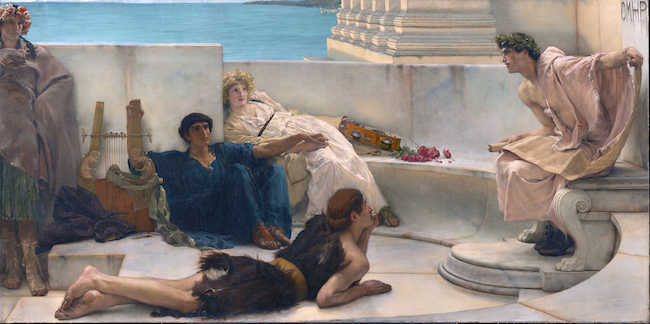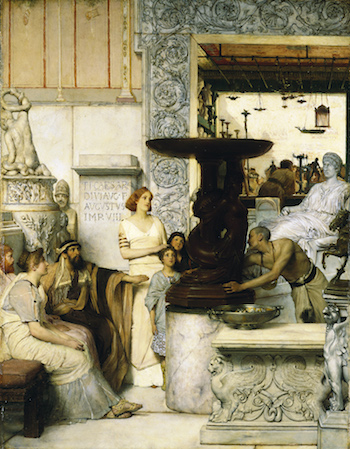Visual Arts Reviews: Decorative Glories of the Gilded Age at The Clark
The exhibition provides a once-in-a-lifetime opportunity to view masterpieces of the decorative arts.
Orchestrating Elegance: Alma-Tadema and Design, at the Clark Art Institute, Williamstown, MA, through September 4.

The Alma-Tadema designed grand piano from the Marquand Music Room. Image courtesy of Clark Art Institute.
by Charles Giuliano
In addition to appreciating the remarkable depth of the French impressionists Pierre Auguste Renoir and Claude Monet, Sterling and Francine Clark were typical mega-rich of their era: they were attracted to the meticulous renderings and smarmy narratives of the French and British academic and salon masters, including William-Adolphe Bouguereau, Jean-Léon Gérôme, and Sir Lawrence Alma-Tadema, the focus of this exhibition.
The ascendancy of modernism in the 20th century generated an aesthetic shift. The value of works by such acclaimed masters (Alma-Tadema, et al) of what is derisively known as l’ art pompier plummeted. Their once-sought after paintings sold for a pittance and languished in the basements of museums.
In 1986 a reversal of aesthetic fortune occurred when a former railroad terminal was transformed into the Musée d’Orsay. This metamorphosis gave birth to a revisionist agenda, an interest in displaying the entire spectrum of 19th century French art. Yet again the general public was invited to compare and contrast the once dominant academic artists with those who were rejected and then shown in the 1863 Salon de Refusés.
With hindsight, the Clarks’ taste for highly polished erotica was prescient. Though stridently politically incorrect, Bougereau’s Nymphs and Satyr, Gérôme’s The Snake Charmer, and Alma-Tadema’s The Women of Amphissa occupy pride of place in the Clark Art Institute’s refurbished and expanded galleries.
Based on a passage by Plutarch, the Alma-Tadema painting gives us maenads — followers of Bacchus, the god of wine — who awaken in the marketplace of Amphissa, Greece. They have wandered from their home in Phocis during a night of ritual dancing. Amphissa and Phocis are at war, but the women of Amphissa offer the bacchantes nourishment and protection. It was acquisitioned in 1978.
The painting is remarkable for the delicacy of its milky tonalities of white on white. In addition to the layered rendering of the garments of the women, the artist labored on the translucency of the marble on which the dissolute maenads are dispersed, lying about in states of satiation and dishabille. One may imagine how easily the sensuous image inspired the lurid imagination and repressed passions of tasteful Victorians.
In 1997 the museum purchased Alma-Tadema’s ornately decorated Model D Pianoforte Steinway grand piano.

Alma-Tadema “A Reading from Homer” courtesy of the Philadelphia Museum of Art.
It was a part of the furnishings that Henry Gurdon Marquand (1819-1902) commissioned from Alma-Tadema for the music room of his Richard Morris Hunt designed mansion at Madison Avenue and 68th Street. The mansion cost $125,000, but Marquand spared no expense for the music room, which cost $50,000.
It has taken a decade of research for the curators Kathleen M. Morris and Alexis Goodin to assemble Orchestrating Elegance: Alma-Tadema and Design which reunites 12 of the original 19 pieces of Marquand’s music room.
The galleries are installed to lead us gradually though the career of Alma-Tadema, from the artist of Greco-Roman classical revisionism to his extraordinary accomplishments as a designer and decorator of furniture.
Carlo di Borbone began excavations at Pompeii in 1748. Great discoveries were being made when Alma-Tadema visited the site in 1863, where he made sketches and studies which evolved into an archive and library.
He strove to inform his paintings with accurate details, as is evident in the pastiche painting The Sculpture Gallery in the exhibition. The clutter of objects in the composition were inspired by recent archaeological discoveries.
This was a passion shared with his patron, Marquand, who amassed a private collection of some 2,400 items, including decorative objects, paintings, etchings, and engravings. He was a founding trustee of the Metropolitan Museum of Art in 1870. Many of the works he acquired, including antiquities, a Vermeer, four Rembrandts and two works by Van Dyck, were given to the Met.
The rooms of the mansion were decorated with different themes, from English renaissance to Byzantine and Japanese. The building and its contents were sold when he died in 1902. The collection was dispersed and the mansion was later razed and replaced by an upscale condo building known as The Marquand.
The designs by Alma-Tadema were executed by the British firm Johnstone, Norman & Co. The case for the grand piano was completed in London and then sent to Steinway, which inserted the instrument. An adjoining gallery documents the many famous musicians who performed on it.
Another gallery focuses on the fascinating “Jupes Patent, Extending Dining Table” 1839 from Johnstone, Jupe & Co. There is an intriguing wall that contains diagrams of the table, which can be rotated to remove (or insert) wedged sections that neatly expand or contract it. There is a riveting video that demonstrates how cleverly and efficiently this is done.

Alma-Tadema “The Sculpture Gallery” courtesy of Clark Art Institute.
Relentless detective work went into tracking down and securing loans from museums and private collections. The search included borrowing the Philadelphia Museum’s Alma-Tadema painting A Reading from Homer (1885) which was commissioned to be hung over the settee. The artist labored over the painting for several years; then he started over with a fresh canvas and completed it in a matter of weeks. It was often borrowed for exhibitions, including The 1893 World Columbian Exposition in Chicago.
The galleries culminate with the furnishings in the music room, and the impact is distinctly double-edged: you either want to marvel at the remarkable decorative objects or roll your eyes at what looks like the over-the-top set of a Cecil B. DeMille silent movie pot boiler. Given such outrageous extravagance and excess, attraction and repulsion compete. One may all too readily imagine this as a room in Trump Tower.
Still, it is hard not to be seduced by The Women of Amphissa and other objects that conjure up a visual orgy. We are ravished by the opulence of the lavish inlay of the piano and accompanying classical styled chairs. There are the magnificently carved front legs that support the piano, as well as ebony and ivory patterning around the edges at the top. The lifted lid is richly ornamented.
The exhibition provides a once-in-a-lifetime opportunity to view masterpieces of the decorative arts. Yet its Gilded Age opulence also invites ironic social and political reflections on the widening income disparity of today. The financier and philanthropist spent lavishly on his home and furnishings at a time that the average American survived on an annual income of under $1,000.
Charles Giuliano is publisher/ editor of Berkshire Fine Arts. He will soon publish his fourth book since 2014, Gloucester Poems: Nugents of Rockport. This summer he will jury the annual show for Boston’s Galatea Gallery.
Tagged: Charles Giuliano, Lawrence Alma-Tadema, Orchestrating Elegance: Alma-Tadema and Design
